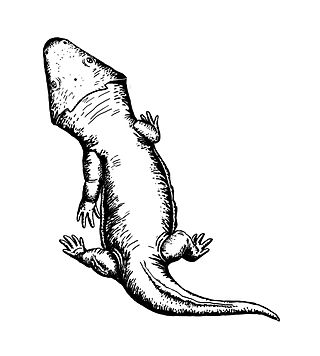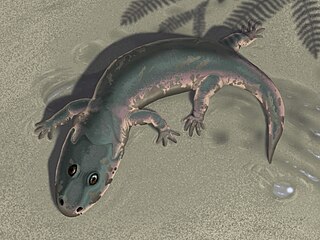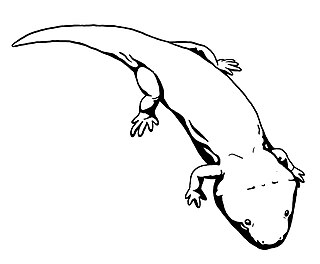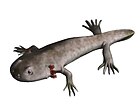
Temnospondyli or temnospondyls is a diverse ancient order of small to giant tetrapods—often considered primitive amphibians—that flourished worldwide during the Carboniferous, Permian and Triassic periods, with fossils being found on every continent. A few species continued into the Jurassic and Early Cretaceous periods, but all had gone extinct by the Late Cretaceous. During about 210 million years of evolutionary history, they adapted to a wide range of habitats, including freshwater, terrestrial, and even coastal marine environments. Their life history is well understood, with fossils known from the larval stage, metamorphosis and maturity. Most temnospondyls were semiaquatic, although some were almost fully terrestrial, returning to the water only to breed. These temnospondyls were some of the first vertebrates fully adapted to life on land. Although temnospondyls are amphibians, many had characteristics such as scales and armour-like bony plates that distinguish them from the modern soft-bodied lissamphibians.

Laidleria is an extinct genus of temnospondyl that likely lived between the Early to Middle Triassic, though its exact stratigraphic range is less certain. Laidleria has been found in the Karoo Basin in South Africa, in Cynognathus Zone A or B. The genus is represented by only one species, L. gracilis, though the family Laidleriidae does include other genera, such as Uruyiella, sister taxon to Laidleria, which was discovered and classified in 2007.

Deltasaurus is an extinct genus of Carnian temnospondyl amphibian of the family Rhytidosteidae.

Lydekkerinidae is a family of stereospondyl temnospondyls that lived in the Early Triassic period. During this time period, lydekkerinids were widely distributed, with putative remains reported from Russia, Greenland, India, South Africa, Madagascar, Australia, and Antarctica. In contrast to most other stereospondyls, lydekkerinids were relatively small-bodied. The type genus is Lydekkerina, the namesake of the family and the best-known lydekkerinid.
Rhytidosteoidea is a superfamily of Temnospondyli, early amphibian species that existed during the Carboniferous, Permian, and Triassic periods. The taxon was established in 1965 to accommodate two new species of Deltasaurus, the author recognising an alliance with previously described genera.
Almasaurus is an extinct genus of trematosaurian temnospondyl within the family Latiscopidae. It is known from several skulls and some postcranial material found from the Argana Formation in Morocco, which dates back to the Late Triassic.

Cryobatrachus is an extinct genus of temnospondyl amphibian from the Early Triassic of Antarctica. The type species is Cryobatrachus kitchingi. It is known from a partial skull and an imprint of the skull roof, both found in the Fremouw Formation of the Transantarctic Mountains at about 85° south latitude and described in 1974. Many small bone fragments have also been identified, although they cannot be attributed with certainty to C. kitchingi. Cryobatrachus has been classified in the family Lydekkerinidae, as it is similar in appearance to the genus Lydekkerina from South Africa. Because only a small number of features distinguish it from other lydekkerinids, Cryobatrachus kitchingi has more recently been considered a nomen dubium, meaning that its distinction from other better-known species may be unwarranted.

Indobrachyops is an extinct genus of temnospondyl amphibian from the Early Triassic of India. It is known from a nearly complete fossil skull that was first described by paleontologists Friedrich von Huene and M. R. Sahni in 1958 from the Panchet Formation in Raniganj Coalfield. Indobrachyops belongs to a group of mostly semi-aquatic temnospondyls called Stereospondyli, but its exact placement within the group has been uncertain since its first description.
Hyperokynodon is an extinct genus of trematosaurian temnospondyl within the family Trematosauridae. Fossils have been found in Germany. While most trematosaurids existed during the Early Triassic, Hyperokynodon has been found in Late Triassic deposits, making it the youngest known trematosaurid. Hyperokynodon was known since 1852, but it was not identified as a trematosaurid until 1987. The type and only species is H. keuperinus.

Lapillopsis is an extinct genus of stereospondyl temnospondyl within the family Lapillopsidae. Fossils belonging to the genus have been found in the Arcadia Formation of Queensland, Australia.
Rotaurisaurus is an extinct genus of amphibian-grade tetrapod from the family Lapillopsidae. This genus is known only from an incomplete crushed skull and associated left jaw, together given the designation UTGD 87795. The generic name, Rotaurisaurus, is a combination of Latin words translating to "circle-eared lizard". This references the shape of its otic notches, which acquire a circular form due to being partially enclosed by the tabular bones at the back of the skull. The specific name, contundo, references the specimen's poor level of preservation, as it is derived from the Latin word for "squashed".
Rileymillerus is an extinct genus of temnospondyl amphibian from the Late Triassic Post Quarry in the Dockum Group of Texas that was described by John Bolt and Sankar Chatterjee in 2000. The holotype, a nearly complete skull with articulated jaws, is housed at the Museum of Texas Tech University. The genus is named for Riley Miller, who allowed Chatterjee to work on the Post Quarry, and the species is named for the paleontologist John Cosgriff.

Platycepsion wilksoni is an extinct species of prehistoric amphibian, known from partial skeleton deposited in shale at the Gosford Quarry site of the Terrigal Formation in Australia. This specimen may represent a larval stage, as denoted by the presence of external gills, making it the first evidence of larval development in stereospondyls.
Tersomius is an extinct genus of dissorophoid temnospondyl within the family Micropholidae. It is known from the early Permian of North America.

Micropholis is an extinct genus of dissorophoid temnospondyl. Fossils have been found from the Lystrosaurus Assemblage Zone of the Karoo Basin in South Africa and are dated to the Induan. Fossils have also been found from the lower Fremouw of Antarctica.Micropholis is the only post-Permian dissorophoid and the only dissorophoid in what is presently the southern hemisphere and what would have been termed Gondwana during the amalgamation of Pangea.
Pneumatostega is an extinct genus of rhytidosteid temnospondyl from the early Triassic period of Cape Province of South Africa. It is known from the holotype BPI F981, a dorsal mould of a skull roof and from the referred specimen SAM 11188, partial skull fragments and postcranial remains recovered from the Lystrosaurus Assemblage Zone in the Beaufort Group near Middelburg. This genus was named by J. W. Cosgriff and J. M. Zawiskie in 1979, and the type species is Pneumatostega potamia.
Perryella is an extinct genus of dvinosaurian(?) temnospondyl from the Permian of Oklahoma.
Parioxys is an extinct genus of temnospondyl amphibian from the Early Permian of Texas.
Chinlestegophis is a diminutive Late Triassic stereospondyl that has been interpreted as a putative stem caecilian, a living group of legless burrowing amphibians. If Chinlestegophis is indeed both an advanced stereospondyl and a relative of caecilians, this means that stereospondyls survived to the present day; historically the group was thought to have gone extinct by the early Cretaceous. Chinlestegophis jenkinsi, the type and only species, is known from two partial skulls discovered in the Chinle Formation in Colorado.
Stenokranio is a genus of eryopid temnospondyl amphibian from the Permo-Carboniferous Remigiusberg Formation of Germany. It is represented by the type species, Stenokranio boldi, which was named for two specimens collected from the Remigiusberg quarry near Kusel, Saar–Nahe Basin, southwest Germany.






















